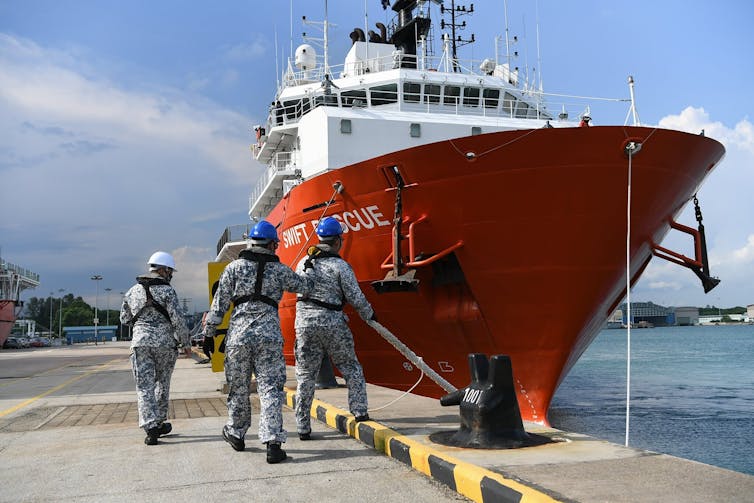Submarines are designed to hide – so what happens when one goes missing?
- Written by James Goldrick, Adjunct Professor in Naval and Maritime Strategy and Policy, Australian National University
In waters north of Bali, a frantic search is underway for the Indonesian submarine KRI Nanggala, missing with 53 crew since the boat failed to make a routine signal report on Wednesday morning.
How to hunt a submarine
There are two key challenges when a submarine goes missing. The first is finding it. A submarine is inherently covert. When the Nanggala dived as part of a routine exercise, it is unlikely the boat was being tracked. Even in a close-range exercise it can be very difficult to maintain sonar contact with a submarine.
While Nanggala may have had a known planned track, the only certainty is where the submarine was when it last reported on Wednesday. Typically, the first indication of a missing submarine, unless there has been an obvious collision with a surface vessel, is the absence of the routine “all is well” report.
Navies have pre-planned procedures for instituting checks and initiating searches if a submarine fails to call in. These are immediately activated when such a report is not received. They rapidly move from what have been termed “SUBLOOK” procedures (looking for a submarine) to “SUBMISS” (submarine is missing) and then, when hope has been lost or evidence of an accident comes in, the self-explanatory “SUBSUNK”.
A large area of uncertainty
However many searchers and however sophisticated their sensors, there will almost always be an area of uncertainty, and it can be very large. The faster the submarine has been moving and the longer the interval since its last check, the greater that area will be.
Submarines have emergency indicator buoys which can be released to mark their position in the event of an accident. That is provided, of course, the accident did not incapacitate the crew.
Read more: The difficulty of searching for MH370 in a giant rubbish patch
In shallow water, the buoys can remain tethered to the submarine. In deep water they become free-floating, so when the buoys are detected search units must calculate back to the estimated release position, with all the uncertainties that wind and currents bring. This is also the case for any debris or oil slicks on the sea surface – such as the one possibly detected by Indonesian units searching for the missing Nanggala.
Difficulties of deep water
The next problem is the ocean floor is rarely flat. Even if the waters are not deep enough to have collapsed the submarine hull under pressure – something that happened to the very similar Argentinian submarine San Juan in 2017 when it sank in 900 metres of water – it can be very hard to detect the vessel among seabed features.
The search for the San Juan, even though aided by triangulation of the seismic signature of its implosion at depth, took a whole year, with minute examination of the seabed using high-frequency sonar and underwater television cameras. It is conceivable the search for the Nanggala could take as long, or longer.
Once the submarine is found, there is no guarantee anyone aboard is still alive, even if the hull has not imploded. If one or more compartments have flooded, there may be survivors in other sections, but they will have limited air. And that is a key problem.
Too much depth, too little time
Time is not on survivors’ side. The problem is, as stated by the Indonesian Navy, that the 53 crewmembers of the Nanggala would have only about 72 hours of air once their submarine is disabled. This would mean air is likely to run out some time on Saturday morning.
It is possible to make individual free ascent escapes from a sunken submarine, but this inherently dangerous procedure becomes increasingly risky as water depth increases. Nanggala was operating in an area with depths of up to 700 metres. This is far, far too deep for such methods, although it is just possible the hull has not imploded.
Even if Nanggala is still intact, however, it is also likely 700 metres is too deep for rescue equipment. There are well-developed international procedures for providing help in the event of a submarine accident, and several rescue ships and systems are being activated by other nations as well as Indonesia.
 A Singapore Navy vessel setting out to assist in the search for the missing submarine.
Ng En Hen / AP
A Singapore Navy vessel setting out to assist in the search for the missing submarine.
Ng En Hen / AP
Ideally, a deep-water rescue unit can be deployed to mate to a hatch on the submarine and embark the survivors – if the hatch is accessible and if the water is not too deep for the rescue unit concerned. But if the boat is near 700 metres, that may be too deep.
In any case, such a submersible has to travel to the scene. While systems such as the 24-person capacity American Deep Submergence Rescue Vehicle (DSRV) can be flown into a region, they then need to be placed aboard a mother ship and sailed to the location of the wreck.
In the case of Nanggala, the Indian Navy has despatched a submarine rescue vessel to help the Indonesians, but this will take around six days to reach the area, and practically every other rescue system that can be made available would also likely arrive too late to help the crew.
And Nanggala has yet to be found.
Read more: Why does Australia need submarines at all?
Authors: James Goldrick, Adjunct Professor in Naval and Maritime Strategy and Policy, Australian National University



















